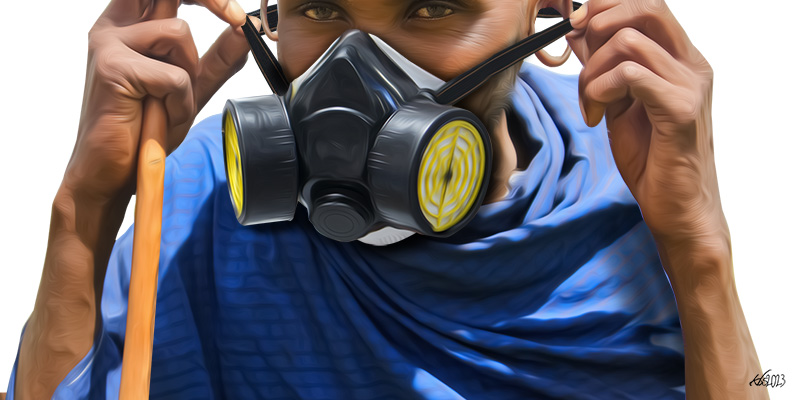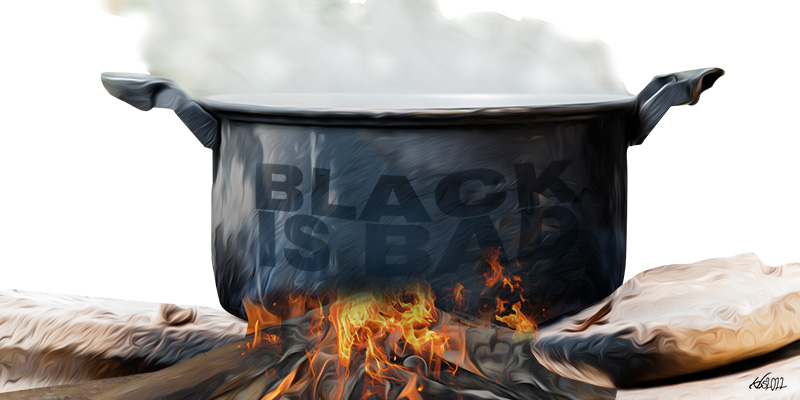Late in 2018, Ben Kitili, a popular TV news anchor, wed Amina Mude at a private event. The two had a three-year-old daughter. Ben had proposed to Amina in 2015. This wedding ran into some controversy. It was described by local bloggers as “a cross-cultural and cross-religious” event; TV anchor Ben Kitili is Christian and from the Kamba tribe and his wife Amina Mude is a Muslim and belongs to a Somali clan from Wajir.
Kitili and Mude were derided for their decision to marry. A section of the Somali community couched its biased sentiments in pseudo-Somali “purity” and “morality” language; others quoted Surah Al Baqarah and Al Mumtahanah and concluded that the marriage was religiously invalid. Words like kafir, murtad, sharmuuto, malaya, un-Islamic, slave, and ugly were used to describe how Amina had broken with tradition to marry a “kufr” and an “adome”. A kafir and a slave.
Some said that economics was at play and that Amina had married Kitili for money. For a majority of the social media fanatics, the bigger shame was that Amina had lowered herself to such depths. Warnings were issued to other girls that what Amina had done was unforgivable.
I wasn’t surprised. This was congruent with the sort of stereotypes that fit the Kenyan national social ethos. I had seen this play out before in real life and in fictional worlds.
My friend Abdul captures this complex dichotomy in his short story “The Somalification of James Karangi“. In this story, James Karangi, a Kikuyu, wants to marry Ayaan, Khalid’s cousin, but in order to do this he must first become a Somali. We watch his futile attempts through his “Somalification” process.
When we first meet Khalid, Karangi and Ayaan are in a restaurant in downtown Mombasa. Khalid says:
“I told you from the beginning…there’s little hope along the line of religion. You could be the Imam and lead all of the late-night prayers in the month of Ramadan, but the Somali guy who steals shoes from the mosque would still stand a higher chance of taking her hand.”
Karangi protests, saying that those were tribal and un-Islamic sentiments, to which Khalid responds:
“…..But you better understand that what we are dealing with here is way beyond tribalism. They are talking of differences in appearance, hair-types and such nonsense.”
Ben Kitili and Amina Mude’s wedding offered an opportunity for a candid conversation, but the viral nature of the matter eclipsed any constructive discussion. The small windows opening up were shutting down just as quickly.
Why is there such bile when in Marsabit and Moyale Borana, Somali, and Gabra girls marry Bantu men? Yet this had been going on for a long time; I have cousins who are half Kikuyu, half Kamba, half Luo etc.
But it should be remembered that the further one moves from the cities, the harder the lines become; that in the popular pastoral mindset, such marriages are almost revolutionary. When such marriages happen, people make references to nose size, skin colour and hair coarseness as things that show differences between all the long-established binaries: Christians and Muslims; farmers and pastoralists; North and South; superior and inferior. People wonder, “Was she blind to have followed such a man?”
In the cities, liberalism triumphed over cultural stereotypes. But Kitili and Amina came to represent something more – mutual feelings of superiority.
Ben Kitili and Amina Mude’s wedding offered an opportunity for a candid conversation, but the viral nature of the matter eclipsed any constructive discussion. The small windows opening up were shutting down just as quickly.
It’s precisely this sentiment that Nasra, a Kenyan Somali comedian, shared on the Churchill Show – how a “Kenyan” man who happens to date a Somali lady flaunts this as an achievement. “Bro mimi nimekula hata bui bui” was met with thunderous laughter. Similarly. Joseph Kamaru, in his song Gathoni, describes a tall slender girl with the hair of a Borana, an object of some kind of sexual fetish.
Away from the fictional world of Ayaan and Karangi, or the reality of Kitili and Mude, we have seen these confrontations playing out before in many everyday scenes. They are captured in xenophobic names like “Gurale” (Blacks) used by Borana speakers when referring to what they call “Bantus”. Other words used are “Gererr” (coarse hair) and “Adome” (slaves). These are words used by Somalis in everyday lingo to refer to the rest of the Kenyan non-nomadic and non-Islamic ethnicities (collectively referred to as Bantu).
Xenophobia
Beyond meta narratives of negations, the canonical biases, the media frames created by the Kenyan media and newly minted utopian narrative of development and of opportunity that sought to supplant half a century of negative state policies and unequal economics through LAPSSET lies something more: an uneasy and intractable cultural division between the North and the South of the country, which is often unexplored and taken for granted.
Opening up the “closed” Northern Kenya cannot suture the badly grafted relationship between the North and the South, between Cushites and Bantus. While the xenophobic relationship between Northern Kenya and Southern Kenya has been noted at different times, its true form has not been fingered properly.
The new development and policy changes on Northern Kenya will have little relevance if they ignore the cultural question, which is premised on mutual suspicion. If Somalis have their stereotypes, so do the Bantus.
In his essay “The Rise of Somali Capital”, Parselelo Kantai, writing in the Chimurenga Chronicle 0f 2013, says:
“Anti-Somali xenophobia has a long tradition in Kenya. The image of the Waria – derogatory slang for Somali – was permanently captured in the 1970s and 1980s in Vioja Mahakamani, Kenya’s longest-running TV court-room comedy…In Vioja, the image of the Somali is represented by Chief Superintendent Wariahe, a tall, light-skinned policeman whose rectitude is only betrayed by his appalling Kiswahili, the source of enduring mirth.
Outside the Wariahe’s clean-cut image, lies another stereotype: that of the Somali as a dirty, khat-chewing Muslim pastoralist more and more at home in the wastelands of Northern Kenya than in the city. In this particular construction, the Somali in the city is a stranger, an invader.”
We meet a version of this Wariah in Binyavanga Wainaina’s memoir, One Day I Will Write about This Place. This Waria is selling items on Kenyatta Avenue:
“…with strange scripts in Arabic, or wrong bottles in the wrong box, or a slightly off-kilter brand name. Porchi. Poisone. Sold by thin thin men from Somalia. Dominos of nations tumble around Kenya – and Somali men walk about, overstimulated, and thrust their faces into yours, dribbling chewed khat, eyes bleary, jacket open and say … Kssss, Kssss, ….Rolexxx….Xss…xxxsss…..SeyKo.”
On the cultural and artistic front, the image of a Northerner has remained the same: infantile, culturally misplaced. Cartoons in the papers depict this one-dimensional character. The image of Wariah, the phlegm spitting, ill-placed nomad, has since the 1970s gone mainstream, jumping off screen, in newspaper clichés, making cameo appearances in Kenyan novels. The ill-fitting pastoralist arrives in agricultural Kenya through these frames. Any Cushite is “Wariah”. (Wariah literally means “hey you!” in Somali, but in Kenya it has become a derogative term used by non-Somalis to refer to Somalis.)
There is another Wariah tag variant that has captured the social dislocation of the pastoralist in the city – “Maasai”. Maasai has become an urban metaphor for clumsiness; to be referred to as “Maasai” is to be made an invalid. “Wacha Umaasai” translates as “Stop your stupidity”.
The function of this division
Our primary school syllabus says that there are three categories of people in Kenya: Bantus, Nilotes and Cushites. But in our minds, there are only two groups: farmers and herders. One sedentary, the other mobile. One Christian, the other Muslim. Both impatient with each other.
Events of these kind speak of a certain Kenyan way of being. Parsalelo argues:
“You also understood that this was a crude form of southern Kenya public therapy. For a people for whom ‘negative ethnicity’, the newspaper euphemism for the prevailing ethnic rancour that had shredded the nation into a farcical edifice of a thousand cuts, ‘othering’ the Somalis restored a sense of collective indignation. Hate and rancour were the only things holding us together.”
In order to understand what this cultural divide has done, we have to look at the past closely. The negative political attitude forged by the Kenyan state against pastoralism found some of its reasons as an offshoot of this cultural division, which is also a function of ecology, geography, religion and lifestyle. The Kenyan state is also modeled on the Westphalia Christian structure. In Kenya, cultural distances between the North and South are found in different structures. The cultural distance is like Sahelian acoustics meeting the rhumba revolution of the sub-Saharan soundscape.
How did this cultural and political orientation confront each other?
What form, if any, did the cultural/political rivalry take?
Has the zenith of this collision been reached?
Is there fear, loathing and intolerance in its construct? Yes. Even an impatience.
Proximity to power and access to resources exacerbates biases. For certain ethnic groups, feelings of nativity and indigeneity take on the form of ethnic entitlement. For others, the Kenya state has its owners.
Our primary school syllabus says that there are three categories of people in Kenya: Bantus, Nilotes and Cushites. But in our minds, there are only two groups: farmers and herders. One sedentary, the other mobile. One Christian, the other Muslim. Both impatient with each other.
Kenya must learn to acknowledge and confront these biases and actively seek to demolish the constructs that continues to divide us.
Muslims in a Christian state
Ali Mazrui showed how “people’s ideas about God can condition their ideas about government”. Kenya is a Christian state in official matters, in its iconography and in its official moral language.
When I was applying for a passport, I sat in the corner where Northern Kenya denizens gather. A young Somali man with his young family sat with me and shared his frustrations. He said, “There is nothing for us Muslims in this country, heri tutoke.”
It was precisely this kind of social division that Al Shabaab wants to exploit by targeting non-Muslims. The church bombings, the selective murder of Christians in Mandera, in Garissa University etc.
Opening up the “closed” Northern Kenya cannot suture the badly grafted relationship between the North and the South, between Cushites and Bantus.
The introduction of police officers as sentries in Kenyan churches resulted in the targetting of any Cushitic-looking believer in the church. Many kinds of humiliation were meted upon the Borana and Rendile Christians in Kenyan churches. They were barred from entering churches, and forbidden from partaking in the Eucharist. They were escorted out of the church for looking like Al Shabaab.
In Kenya, even the school curriculum follows state policy; in its design, the Kenyan syllabus curtails and suppresses cultural and religious differences. In many Kenyan schools, Muslim students are forced to study Christian religious education. For many Muslims joining secondary schools, this fact becomes apparent when they receive admission letters. This prejudiced intolerance will follow them into many offices.
In the late 1990s, as the years of Daniel arap Moi’s presidency in Kenya were waning, a charismatic Member of Parliament, who had served as Kenya’s Foreign Affairs Minister and was at the time the deputy KANU chair, was poised to be the presidential running mate of Uhuru Kenyatta, who was then a rookie politician being fronted by Moi. Curiously, a delegation of Mt. Kenya politicians went to Moi to voice their dissatisfaction with the possibility of Bonaya Adi Godana from North Horr being fronted as Uhuru’s presidential running mate. Their reason was quite simple: they said as a Muslim, Bonaya Adi was unfit for that position. Unbeknownst to them, Bonaya Adi was a Christian.
Ecology as the mother of cultures
Spiritualism was necessary for pastoralist communities facing many uncertainties. Ecology has been a key player in what form of spiritualism was forged. Kenya is highly divided between its green highlands and its arid and semi-arid regions. These two environments induce different forms of spiritualism. This then becomes another key arena where the North-South cultural split plays out.
The Libyan writer Ibrahim Al-Koni in an interview (“In the Desert We Visit Death”), locates this as an old problem. He says:
“The human community was early on split into two major tribes. They were so completely different, as if they came from two different worlds. This evolved through time and resulted in the nomadic tribe and the settled tribe. The nomadic tribe’s capital was freedom. They had no ties to a certain area. So they turned to contemplation which gives birth to freedom. The settled people’s capital was ownership – and all the disasters that ownership entails.”
Ibrahim Al-Koni goes on to say that the “spirit among settled people is dead”. He cites St. Augustine who “called the nomadic tribe the divine tribe because it was a spiritual tribe”. He says this problem has existed since creation. “All the wars that took place in the ancient times took place because of this split.” And that a bitter feud between the spirit (nomadic people) and body (settled people) has been ongoing.
Thus a long history of intervention in changing nomads has been spearheaded by NGOs and the Kenyan state. It is a system that tries to “rehabilitate” the Northern landscape and livelihoods through irrigation agriculture schemes, resettlement, and restocking.
And because of this, for Northerners, allegiance to Kenya (spiritually) was fraught with ambiguities. And as a result, they developed an indomitable nomadic spirit that no level of political, social and economic oppression can break.
Superiority complexes
My friend, a Somali lady, who is liberal, foreign-educated, worldly, progressive and very articulate, someone whose accent can easily be described as “bourgie”, feels very strongly about this matter and has voiced her resentment towards what she considers “Bantu self-disrespect”. She had returned to the UK for a Master’s degree and I somehow expected a change in perspective. I ask her whether she still considered the Bantus to harbour the same feelings. I approached the issue tentatively. I asked, “What do you make of the Southern Kenya people …?” She saw through my caution.
“Who? You mean the Gurales?” and then she laughs
“Yes…..and how Gurale, Adome are racist’s sentiments.”
“It’s their fault, they allow it …when I argue with my friends I often get we wacha kunidharua…It’s like they expect it…”
She broadens the perspective further.
“I often go out with Kikuyu or other Bantu men but the kinds of comments their friends give…ohhhh…manze umewahi!! Umeangukia jo! Eh? Umemtoa wapi msomali…and it makes me feel terrible as if my presence with them was an unattainable goal.”
“Sasa nani amejidharau hapo?”
“When Somali guys see me with Kikuyu men, they look at me with eyes that say I am bringing myself down low.”
“But madharau iko!” I say
“Yes…but it’s the way they see themselves…not how we treat them.”
Simple perceptions, media-engendered images, and minor incidents speak of these cultural divides and impressions: ideas about racial purity, of a superior religion coalescing around one’s ethnicity have easily been intensified, repurposed and allowed to be toxic. This leads to stereotypes of hungry women who almost died when giving birth, who are frigid even, because they were cut up badly while undergoing FGM.
Alienating development projects
To expect mega-infrastructure to suture this division would be to heap a psychological responsibility on physical projects. Zoe Cormack, in her paper “The Promotion of Pastoralist Heritage and Alternative ‘Visions’ for the Future of Northern Kenya “explores how pastoralist heritage and culture is being revalorized in the context of large infrastructural development plans in Northern Kenya”. She mentions the prevailing and perverse anxiety that characterises local perceptions of the new infrastructure projects where “fears have been raised of coming exploitation and that the north will be culturally and politically assimilated into the privatised, sedentary and neo-liberal model of the central state.”
To expect mega-infrastructure to suture this division would be to heap a psychological responsibility on physical projects.
This privatised, sedentary neo-liberal model is visible in the towns of the North. Policies on conservation, rehabilitation of rangelands, and administrative boundaries have led to decreased mobility, which has impacted the pastoralist lifestyle.
How do we confront this bitter reality?
In Yvonne Adhiambo Owuor’s novel Dust, when Odidi and Ajany join school, they take up hobbies: music for Odidi and painting for Ajany.
“Music and painting bandaged soul-holes.
They forgot teachers who asked ‘ati, from where? Is it on the map?’ Drowned out classmates: ‘You people cook dust to eat.’”
Many students from the North face similar scornful comments that follow them silently throughout their lives.
The capital accumulated by Somalis offered better socio-political and economic mobility and increased prospects of fusion and synthesis.
Parsalelo argues that “that ethnic capital mobilised at both an individual and communal level (the notional claims to ethnic-blindness notwithstanding) is still the most effective route to securing economic and political legitimacy.”
The current media presence of a certain class of Somali journalists from Northern Kenya is encouraging. Political representation is also increasing. Uhuru Kenyatta’s regime has been particularly receptive to and accommodative of Northern Kenya politicians.
However, the participation of a few elites in the ivory towers of Kenya’s uneasy and often unholy construct should not be confused with full integration. Other internal ethnic and cultural politics need to be addressed; once Kenyans learn to place a high value on unity and ethnic diversity, then cross-regional cultural harmony can be forged.








